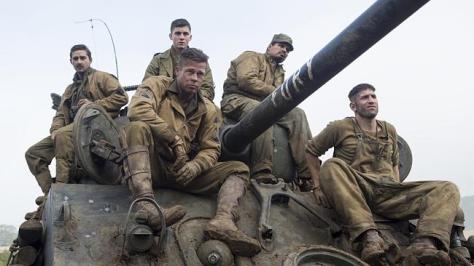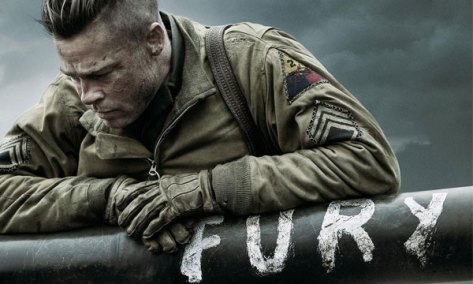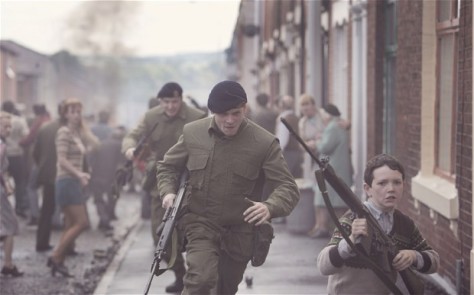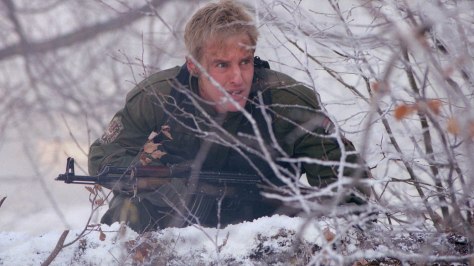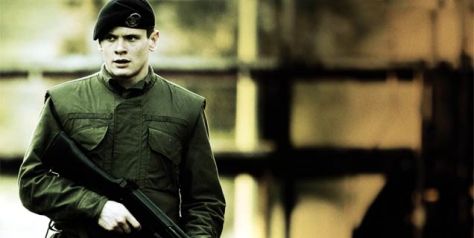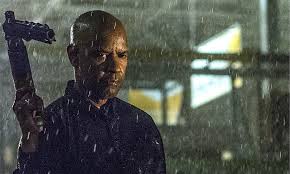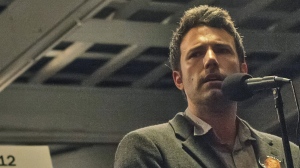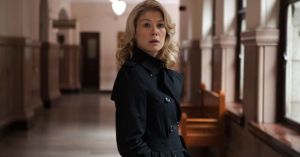FIRST THE GOOD news. In “Fury”, director/writer David Ayer (“End of Watch” “Training Day” – as writer) and his production designer Andrew Menzies (“G.I. Joe, Retaliation”, “Knight and Day” “3.10 to Yuma”) have created an exceptionally convincing, immersive world that feels like the end of the world. Set in Germany, in the waning days of World War II, this is a world of mud, mayhem and mangled bodies. The air is grey, most of the buildings have been reduced to rubble, the sodden streets and pathways are littered with bombed out tanks and other still-smouldering army vehicles, the civilians we meet are hollow-eyed and unkempt, fleeing the destruction for who knows where (including one woman still in her bedraggled once-white wedding dress) and the GI’s are dirty, bloody and mud-stained.
As the movie begins, panning along these scenes of death and destruction, a lone rider on a white horse emerges from the mist, like a phantom, like an angel of death. His solitary silent ride is abruptly cut short when another figure, like a dark shadow pounces down from his mountain of a tank and viciously slaughters him. He sets the horse free. Welcome to the war. And welcome to one of many cleverly surreal images that punctuate the movie.
The figure is tank captain, Sergeant Don “Wardaddy” Collier (Brad Pitt, brilliantly convincing as the emotionally scarred soldier who must never show weakness to his men). He boasts of killing Germans first in Africa, Belgium and now Germany itself. Call him a man with a single-mindedness of focus. He commands a crew of four others, Boyd, “Bible” Swan (a compellingly strong Shia LaBoef), Trini “Gordo” Garcia (Michael Peña – who also acted for Ayer in the under-estimated “End of Watch”) and “Coon-Ass” Grady (Jon Bernthal – “The Wolf of Wall Street”).
Collier’s crew has just lost its key gunner, whose splattered remains and half his face (it’s that kind of movie) are still scattered all over the tank – the dark cave these men call home. In replacement, Collier is assigned a new recruit, Norman Ellison (Logan Lerman – the lover in “Noah”).
Ellison is only eight weeks into the war. He’s a typist, not a gunner. He’s the fictional innocent, whose innocence is lost as Collier teaches him “to be a man” and forces him to learn how to kill. He’s really Collier before Collier became “Wardaddy”. And during the arc of the film’s narrative we see how – presumably like Collier – he learns to hate the Nazis; how the necessity of mass slaughter becomes cathartic; how like his fellow crew-members, he becomes a ruthless GI fighting machine. In the end he too earns his own nickname: “the fighting, fucking, drinking machine” (which doesn’t quite trip off the tongue like “Wardaddy”, but we don’t want to be too fastidious here)
“Fury” is deservedly credited with presenting an unsparingly realistic picture of war. It’s that first ten minutes of “Saving Private Ryan” extended for two hours. We see heads and legs blown off, bodies flattened under the weight of tanks as they trundle through the mud, people hanging from gibbets at the side of the road and you can almost smell the stench of unwashed men (apparently in order to stay in character, Shia LaBoef didn’t wash for the duration of the filming).
Its central conceit, as voiced by Collier, is a simple one, “ideals are for peacetime”. During a war there is only room for the dark atavism of violence. As Collier says, “their job is to kill me, my job is to kill them.” “Fury” is about them – lots and lots of them – being killed.
This gung-ho, macho sentiment is presented to us without any authorial irony. You’d think the one time “ideals” are needed is precisely during a war. And there is some token smoke-screen fluff about God and faith as if to buttress the gore-fest indulgence of “Fury’s” “World of Warcraft” violence. But this is a movie (one critic coyly called it an “old fashioned war movie”) that harks back to the gloriously innocent days of actors like Audy Murphy in “To Hell and Back” and Robert Ryan in “Battle of the Bulge” and “The Longest Day”. It proudly reminds us, in case we forgot, that the GI’s single-handedly saved the world from tyranny and the US held the high moral ground.
Should you feel moved to go to “Fury”, leave your brain (and your German friends) outside the door; fill its cavity instead with the Stars and Stripes. For this is an obscene escapist fantasy that plays to a no doubt cheering audience perhaps needing the reassurance that the sixty post-war years during which democracies were undone by the CIA, nations bombed, civilians strafed, and innocents tortured and Guantanomo-ed never really existed. Ayer’s macho filmmaking offers us no meta-narrative, no deeper rumination to filter the on-screen carnage. His last triumphant image is an aerial shot of Fury, Collier’s Sherman tank, surrounded by the strewn bodies of countless German dead, flung like so many sticks upon the ground.
Roland Barthes noted that the crucial difference between the US and England was that the US was driven by a sense of its mythology, whereas England was driven by a sense of its history.
“Fury” purports to be unvarnished history.
It’s simply mindless, revisionist myth making

